To organize a minimalist closet, start by evaluating what you wear regularly and donate what’s unused. Define your style and pick versatile, cohesive pieces in neutral tones. Sort clothing by season and store off-season items separately. Use clear containers and labels to maximize storage, and keep accessories tidy. Rotate clothes seasonally to maintain simplicity. Incorporate sustainable choices and personalize your space with meaningful decor. Keep everything streamlined with consistent maintenance—if you continue exploring, you’ll discover tips for a truly effortless closet.
Key Takeaways
- Assess and declutter your wardrobe, keeping only essential, frequently worn items and rotating seasonal clothing to minimize excess.
- Define your personal style and organize clothing and accessories for easy access and visual harmony.
- Implement efficient storage solutions like labeled containers, vertical shelving, and hooks to maintain a tidy, minimalist space.
- Choose a cohesive color palette and similar fabric textures to simplify outfit coordination and enhance versatility.
- Practice sustainable habits such as buying secondhand, repairing clothes, and washing with eco-friendly products to support an eco-conscious wardrobe.
Assess Your Current Wardrobe

Have you ever wondered what clothes you actually wear versus what just takes up space? Evaluating your current wardrobe helps you identify these items. Start by sorting through everything, keeping only pieces you genuinely use. Pay attention to seasonal accessories—those scarves, hats, or jewelry you wear during specific times—and decide if they’re necessary or clutter. Consider your laundry routines too; if certain clothes rarely get cleaned or worn, they might not suit your daily life. Be honest about what fits your style and needs. This process helps you see what’s essential and what’s excess, making it easier to create a streamlined wardrobe. Removing unused clothing sets the foundation for a minimalist closet that’s functional and easier to maintain. Additionally, projector contrast ratios can influence your perception of color and detail, helping you understand which items truly stand out in your wardrobe.
Define Your Style and Needs
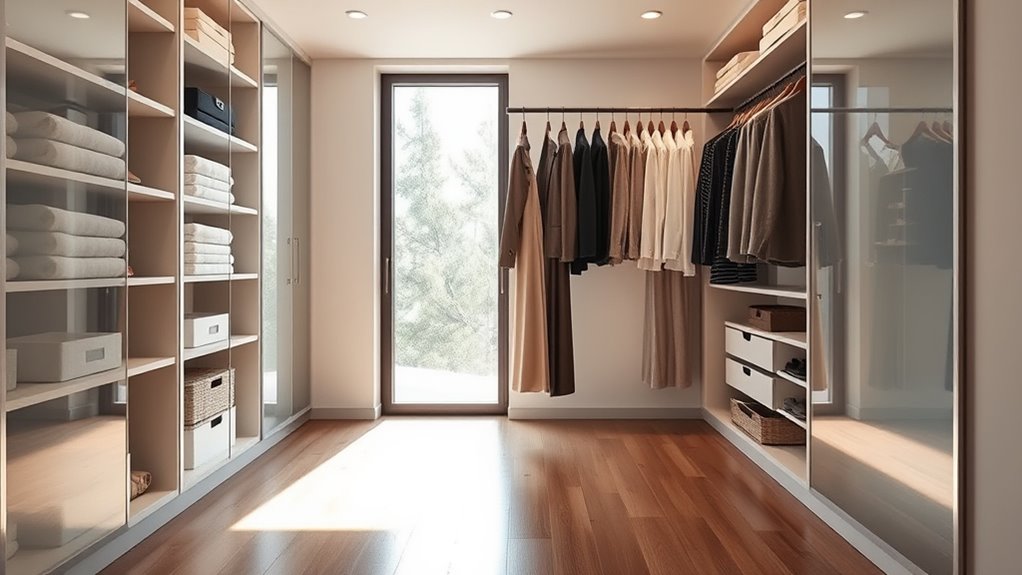
Understanding your personal style and daily needs is essential before building a minimalist wardrobe. When you define what fits your lifestyle, you can select versatile fabrics that last and suit multiple occasions. Accessorize thoughtfully to elevate simple outfits without cluttering your closet. Incorporate color coordination to maximize outfit options and maintain a cohesive wardrobe.
Sort and Declutter Effectively
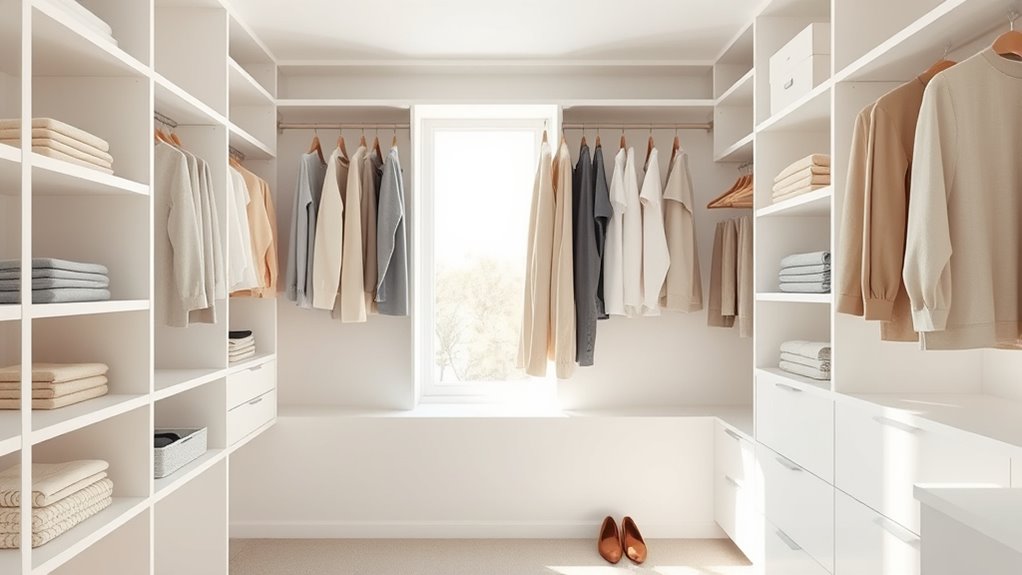
To start sorting your closet, use clear strategies like grouping similar items and setting aside space for essentials. Decluttering becomes easier when you ask yourself if you’ve worn something in the past year or if it truly matches your style. Applying simple tips and tricks can help you let go of unnecessary clothes and create a streamlined, minimalist wardrobe. Additionally, understanding your clothing weight can assist in organizing storage and planning for potential moves or renovations.
Sorting Strategies for Success
Effective sorting is the key to transforming your closet into a minimalist space. Start by considering seasonal transitions; organize your clothing so that off-season items are stored separately, making it easier to focus on what you wear now. When sorting, keep only pieces that fit well and make you feel confident. For accessory organization, categorize items like belts, scarves, and jewelry, ensuring they’re easily accessible and decluttered. Use clear containers or designated drawers to prevent clutter buildup. As you sort, be honest about what you actually wear regularly. This helps prevent unnecessary accumulation and keeps your closet streamlined. Additionally, exploring different clothing organization techniques can further enhance your space. Consistently applying these strategies guarantees your closet remains functional, minimal, and easy to navigate, making daily dressing simple and stress-free.
Decluttering Tips and Tricks
Decluttering your closet starts with making decisive choices about what truly belongs in your space. Focus on identifying items you no longer wear or need, especially during seasonal shifts. Use donation strategies to give away clothes in good condition, freeing up space and helping others. When sorting, ask yourself:
- Have I worn this in the past year?
- Does it fit my current style?
- Is it suitable for upcoming seasonal changes?
- Would I genuinely miss it if gone?
Be honest with yourself, and set aside clothes for donation or resale. Group items by season, storing off-season clothing separately to simplify your choices later. This strategic approach helps you keep only what you love and use, making your closet more functional and minimalist. Additionally, understanding closet organization principles can further streamline your space.
Choose a Color Palette and Cohesive Pieces
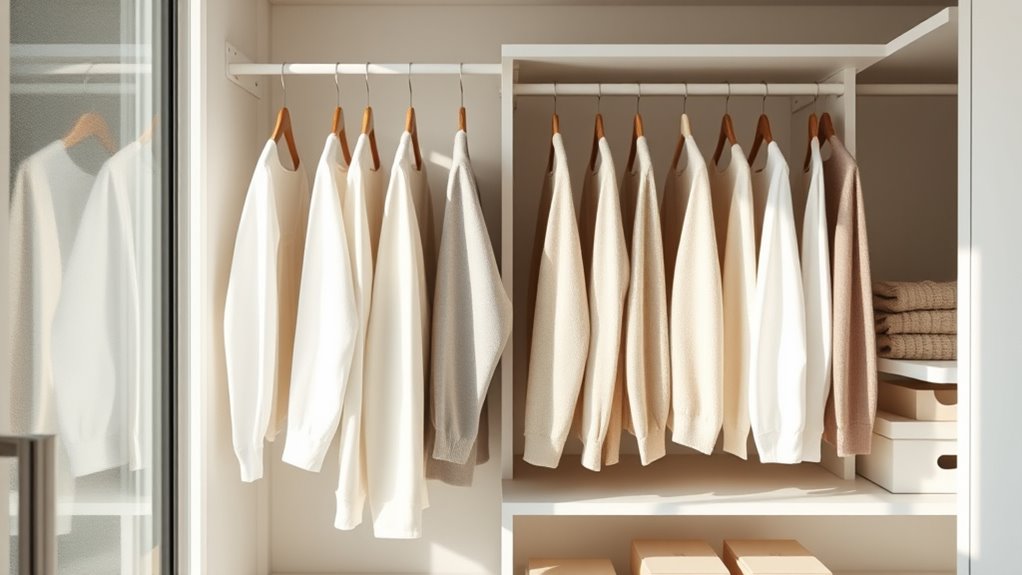
Choosing a color palette and cohesive pieces is essential for creating a minimalist closet that feels balanced and effortless. Focus on color harmony by selecting shades that complement each other, making outfit coordination simple. Stick to neutral tones like black, white, beige, or gray, and add a few accent colors for variety. Guarantee fabric coordination by choosing similar textures to maintain a cohesive look. Use the table below to plan your palette:
| Primary Colors | Accent Colors |
|---|---|
| Black | Mustard |
| White | Navy |
| Gray | Olive |
| Beige | Blush |
This approach helps your wardrobe stay versatile, easy to mix, and visually appealing, supporting your minimalist aesthetic. Additionally, considering wardrobe organization strategies can further enhance the simplicity and functionality of your closet.
Optimize Storage Solutions

To make the most of your closet space, focus on maximizing vertical areas with shelves and hanging organizers. Using clear containers helps you see your items at a glance, reducing clutter. These simple tweaks keep your closet streamlined and easy to maintain. Additionally, incorporating support networks can provide encouragement and advice as you develop your minimalist wardrobe.
Maximize Vertical Space
Maximizing vertical space is one of the most effective ways to optimize your closet storage. By utilizing hanging solutions and smart shelf organization, you can make the most of every inch. Install double hanging rods to create two levels for shirts and pants, freeing up shelf space. Use tall, slim storage units or wall-mounted shelves to keep accessories and shoes off the floor. Consider adding hooks or pegboards for belts, scarves, or bags, keeping them accessible yet tidy. Vertical dividers on shelves can separate clothing categories, enhancing organization. Think vertically—stack sweaters or place storage bins on high shelves. Incorporating sustainable storage options made from eco-friendly materials can further support your minimalist lifestyle. This approach not only maximizes space but also keeps your closet clean and clutter-free, making it easier to find and maintain your minimalist wardrobe.
Use Clear Containers
Using clear containers is a straightforward way to keep your closet organized and your items easily accessible. They allow you to see what’s inside at a glance, saving time and reducing clutter. To enhance this system, label boxes so you know exactly what’s stored without opening each container. This is especially helpful for seasonal clothing or accessories. Stacking containers maximizes vertical space, making the most of your closet’s height. When stacking, ensure heavier boxes are on the bottom for stability. Keep similar items together in uniform containers for a tidy look and easier retrieval. Regularly review and declutter to prevent accumulation of unused items. Clear containers, combined with labeling and stacking, create a streamlined, minimalist closet that’s simple to maintain. Additionally, understanding privacy policy and cookie management can help you control your online data preferences while browsing storage solutions online.
Implement a Rotation System
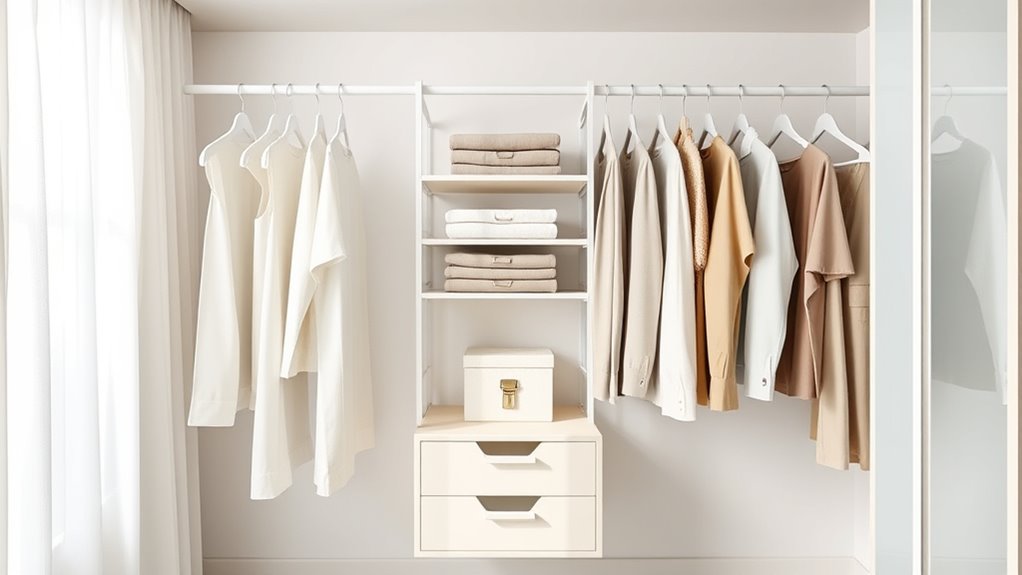
Implementing a rotation system is essential for maintaining a minimalist closet. It helps you manage seasonal storage and guarantees your wardrobe stays fresh and functional. By rotating your clothing, you avoid clutter and make space for pieces you truly love. Picture yourself regularly swapping out items based on the season, keeping only what you wear often. This process encourages mindful clothing choices and reduces impulse buys. Imagine pulling out lightweight summer dresses in winter and storing heavy sweaters away, or vice versa. Use these visuals to guide your clothing rotation:
- Seasonal storage bins neatly labeled and stacked
- Freshly rotated pieces hung prominently
- Out-of-season clothes tucked away in hard-to-reach spots
- Everyday favorites front and center
Stay consistent, and your minimalist closet will stay organized and clutter-free. Regularly assessing and rotating items helps prevent clutter buildup and maintains a mindful, sustainable wardrobe.
Maintain Your Minimalist Closet

Once you’ve set up a rotation system, the key to keeping your closet minimalist is regular maintenance. Start by making seasonal adjustments, swapping out clothing to match weather changes while removing items you no longer wear. This helps prevent clutter and keeps your wardrobe fresh. Stick to your wardrobe budgeting by regularly evaluating your clothing choices, ensuring each piece serves a purpose and fits your style. Set aside time monthly to tidy up, put away out-of-season items, and reassess your collection. Avoid impulse buys that don’t align with your minimalist goals. Consistent maintenance keeps your closet manageable and intentional, helping you enjoy a streamlined wardrobe that suits your lifestyle without unnecessary excess.
Incorporate Sustainable Practices
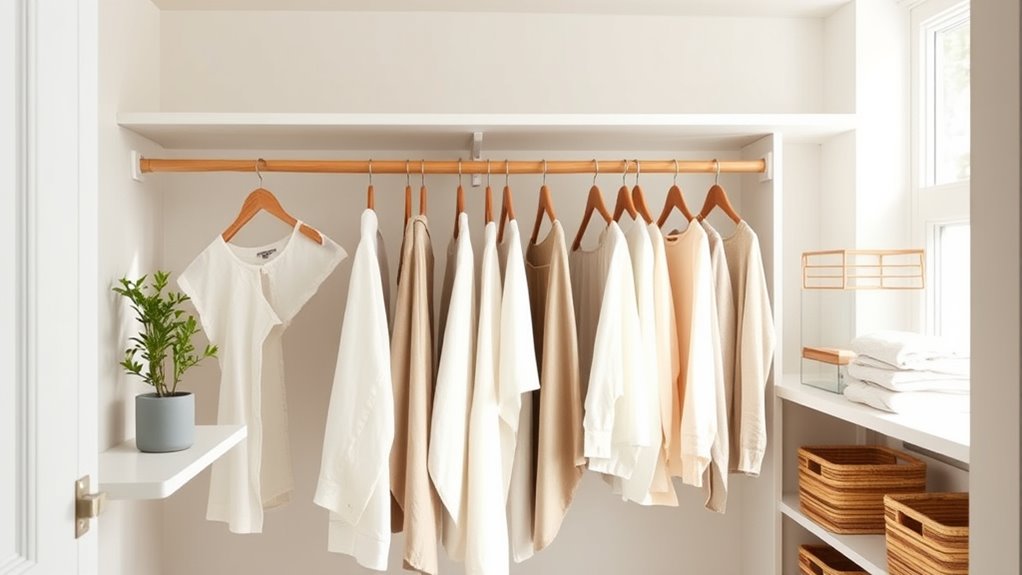
Incorporating sustainable practices into your minimalist closet not only benefits the environment but also reinforces your commitment to mindful living. Choose clothing made from sustainable fabrics like organic cotton, hemp, or recycled materials to reduce your ecological footprint. When doing laundry, opt for eco-friendly detergents and wash clothes in cold water to save energy and extend their lifespan. You can also reduce waste by repairing or repurposing clothing instead of discarding it. Consider buying secondhand or from brands committed to ethical production. By making these small adjustments, you support sustainability while maintaining a streamlined wardrobe. Visualize hanging organic cotton tees, recycling worn-out jeans, and carefully washing delicate fabrics—each step helps you build a more eco-conscious closet.
Personalize Your Space for Inspiration
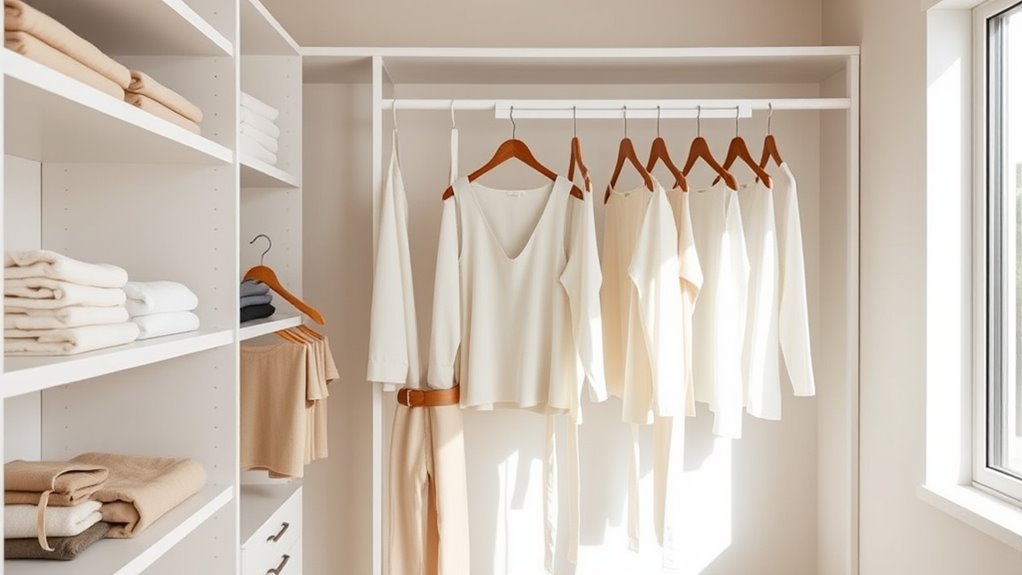
Personalizing your space for inspiration creates a motivating environment that encourages mindful wardrobe choices. Incorporate personalized decor, such as framed photos or meaningful artwork, to make your closet feel uniquely yours. Inspirational accessories like stylish jewelry trays or decorative storage boxes can add visual interest while keeping essentials accessible. Keep your space clutter-free, allowing these personal touches to stand out. Use colors and textures that energize you, creating a positive vibe each time you open your closet. By adding thoughtful details, you transform your closet into a space that fuels your motivation to maintain a minimalist wardrobe. This intentional approach helps reinforce your style goals and keeps you inspired to make conscious clothing choices every day.
Frequently Asked Questions
How Often Should I Revisit and Update My Minimalist Wardrobe?
You should revisit your minimalist wardrobe every few months to stay on top of wardrobe maintenance and style updates. Regularly evaluating your clothing helps you identify items you no longer wear or need, keeping your closet streamlined. This routine ensures your wardrobe reflects your current style, fits well, and remains clutter-free. By doing so, you maintain a functional, stylish closet that truly serves your needs, making dressing effortless and enjoyable.
What Are Some Budget-Friendly Ways to Expand a Minimalist Closet?
Thinking about expanding your minimalist closet on a budget? Irony alert: thrift shopping and clothing swaps are your best friends! You can find stylish pieces without breaking the bank, and swapping clothes keeps your wardrobe fresh without excess. These options are eco-friendly, fun, and budget-savvy. So, embrace the thrift store treasure hunt or organize a swap with friends—your minimalist closet will thank you for the thoughtful additions!
How Can I Maintain Motivation to Keep My Closet Minimal?
To stay motivated to keep your closet minimal, seek out regular wardrobe inspiration through fashion blogs or social media. Set motivational tips like celebrating small decluttering wins or visualizing your ideal minimalist wardrobe. Keep reminding yourself of the benefits, such as easier mornings and less stress. By focusing on your goals and invigorating your inspiration, you’ll find it easier to maintain your minimalist approach long-term.
What Are Common Mistakes to Avoid When Organizing a Minimalist Closet?
They say, “A stitch in time saves nine,” and that’s true for your closet too. Avoid mistakes like clutter accumulation and improper categorization, which can quickly undo your efforts. Keep a regular schedule for decluttering and make sure to categorize clothes logically. Don’t let clutter build up or mix items unnecessarily. Staying organized requires effort, but it’s worth it to maintain a minimalist closet that’s both functional and calming.
How Do I Handle Seasonal Clothing Changes in a Minimalist Wardrobe?
When handling seasonal clothing, you should focus on seasonal storage and clothing rotation. Store off-season items in a separate bin or under-bed container to keep your closet decluttered. Rotate your wardrobe by bringing out seasonal pieces while packing away the current season’s clothes. This approach helps you maintain a minimalist wardrobe, making it easier to find what you need and preventing clutter from piling up.
Conclusion
Imagine your closet as a well-tended garden—each piece a flower, carefully chosen and nurtured. When you organize with intention, you’ll find more space to breathe and enjoy what truly sparks joy. Studies show minimalist wardrobes can save you time and reduce decision fatigue. Just like pruning dead branches, decluttering your closet clears the way for a more peaceful, stylish life—making every morning feel like a fresh bloom.









